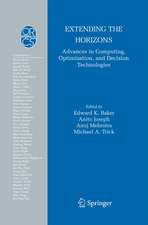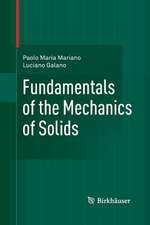Experimental Design for Laboratory Biologists: Maximising Information and Improving Reproducibility
Autor Stanley E. Lazicen Limba Engleză Paperback – 7 dec 2016
| Toate formatele și edițiile | Preț | Express |
|---|---|---|
| Paperback (1) | 427.80 lei 3-5 săpt. | |
| Cambridge University Press – 7 dec 2016 | 427.80 lei 3-5 săpt. | |
| Hardback (1) | 1091.15 lei 3-5 săpt. | |
| Cambridge University Press – 7 dec 2016 | 1091.15 lei 3-5 săpt. |
Preț: 427.80 lei
Nou
Puncte Express: 642
Preț estimativ în valută:
81.86€ • 85.47$ • 67.75£
81.86€ • 85.47$ • 67.75£
Carte disponibilă
Livrare economică 14-28 martie
Preluare comenzi: 021 569.72.76
Specificații
ISBN-13: 9781107424883
ISBN-10: 1107424887
Pagini: 422
Ilustrații: 124 b/w illus.
Dimensiuni: 190 x 245 x 20 mm
Greutate: 0.94 kg
Editura: Cambridge University Press
Colecția Cambridge University Press
Locul publicării:New York, United States
ISBN-10: 1107424887
Pagini: 422
Ilustrații: 124 b/w illus.
Dimensiuni: 190 x 245 x 20 mm
Greutate: 0.94 kg
Editura: Cambridge University Press
Colecția Cambridge University Press
Locul publicării:New York, United States
Cuprins
1. Introduction: 1.1 What is reproducibility?; 1.2 The psychology of scientific discovery; 1.3 Are most published results wrong?; 1.4 Frequentist statistical interference; 1.5 Which statistics software to use?; 2. Key ideas in experimental design: 2.1 Learning versus confirming experiments; 2.2 The fundamental experimental design equation; 2.3 Randomisation; 2.4 Blocking; 2.5 Blinding; 2.6 Effect type: fixed versus random; 2.7 Factor arrangement: crossed versus nested; 2.8 Interactions between variables; 2.9 Sampling; 2.10 Use of controls; 2.11 Front-aligned versus end-aligned designs; 2.12 Heterogeneity and confounding; 3. Replication (what is 'N'?): 3.1 Biological units; 3.2 Experimental units; 3.3 Observational units; 3.4 Relationship between units; 3.5 How is the experimental unit defined in other disciplines?; 4. Analysis of common designs: 4.1 Preliminary concepts; 4.2 Background to the designs; 4.3 Completely randomised designs; 4.4 Randomised block designs; 4.5 Split-unit designs; 4.6 Repeated measures designs; 5. Planning for success: 5.1 Choosing a good outcome variable; 5.2 Power analysis and sample size calculations; 5.3 Optimal experimental designs (rules of thumb); 5.4 When to stop collecting data?; 5.5 Putting it all together; 5.6 How to get lucky; 5.7 The statistical analysis plan; 6. Exploratory data analysis: 6.1 Quality control checks; 6.2 Preprocessing; 6.3 Understanding the structure of the data; Appendix A. Introduction to R; Appendix B. Glossary.
Recenzii
'This is a wonderfully lucid introduction to experimental design, written by an author who is clearly aware of the pitfalls that exist for the unwary experimenter. The focus is on how to design experiments to ensure reproducible research, with many examples illustrating general principles that need to be understood to avoid error and bias. The coverage of statistical analysis follows on naturally from the design issues, and is amply illustrated with exercises in R. Highly recommended.' Dorothy Bishop, University of Oxford
'Worldwide there is a salient discussion about deficiencies in the validity and predictiveness of research in the life sciences. Indeed, a fullblown 'reproducibility crisis' has been proclaimed. Against this backdrop this important textbook is a timely and highly useful contribution in the pressing quest to improve the robustness, rigor, and reproducibility of current biological and preclinical research. Proper experimental design is the bedrock for obtaining reliable evidence. By providing the necessary conceptual know-how and practical knowledge, [this book] enables investigators in all stages of their careers to minimize bias and improve statistical power through proper design and analysis of their experiments. This volume is unique … [as] it is immensely readable and accessible even for those with little previous knowledge, in combining all relevant aspects in a practical, concise and comprehensive manner, and in its clear focus on factors that help to improve the quality of research.' Ulrich Dirnagl, Charité University Hospital, Germany
'There is an increasing need to better design experiments not only to reduce the number of any animals being used in any such work, but also to ensure that the data so produced is meaningful. As part of that process knowing how to power studies and then properly analyse the data so generated is vital, and of late there have been concerns that this is not been done to same vigour as that seen in the clinical arena. However, most scientists struggle with this aspect of their work, and thus it is really refreshing to come across a book that explicitly deals with experimental design and analysis. This new book clearly lays out what can and should be done and is written by an acknowledged expert and I have no doubt that this book will become a recommended read for all those contemplating undertaking work of this type.' Roger Barker, University of Cambridge
'Worldwide there is a salient discussion about deficiencies in the validity and predictiveness of research in the life sciences. Indeed, a fullblown 'reproducibility crisis' has been proclaimed. Against this backdrop this important textbook is a timely and highly useful contribution in the pressing quest to improve the robustness, rigor, and reproducibility of current biological and preclinical research. Proper experimental design is the bedrock for obtaining reliable evidence. By providing the necessary conceptual know-how and practical knowledge, [this book] enables investigators in all stages of their careers to minimize bias and improve statistical power through proper design and analysis of their experiments. This volume is unique … [as] it is immensely readable and accessible even for those with little previous knowledge, in combining all relevant aspects in a practical, concise and comprehensive manner, and in its clear focus on factors that help to improve the quality of research.' Ulrich Dirnagl, Charité University Hospital, Germany
'There is an increasing need to better design experiments not only to reduce the number of any animals being used in any such work, but also to ensure that the data so produced is meaningful. As part of that process knowing how to power studies and then properly analyse the data so generated is vital, and of late there have been concerns that this is not been done to same vigour as that seen in the clinical arena. However, most scientists struggle with this aspect of their work, and thus it is really refreshing to come across a book that explicitly deals with experimental design and analysis. This new book clearly lays out what can and should be done and is written by an acknowledged expert and I have no doubt that this book will become a recommended read for all those contemplating undertaking work of this type.' Roger Barker, University of Cambridge
Notă biografică
Descriere
A guide to designing lab-based biological experiments that have low bias, high precision and widely applicable results.

























